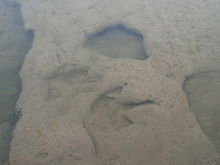Glen J. Kuban
Glen Jay Kuban (* 1957 near Cleveland , Ohio ) is an American biologist . He became known for his extensive work on the Paluxy River footprints .
Life
Glen J. Kuban was born near Cleveland, where he grew up. In 1979 he completed his studies in biology at the College of Wooster with a Bachelor of Arts (BA) degree . He also has a teaching license . He was chairman of the Fossil Society of the Cleveland Museum of Natural History and worked as a programmer for various companies. Kuban is also a member of the American Scientific Affiliation and the Mid-America Paleontology Society
Kuban took an early interest in paleontology , as well as ongoing evolution - creationism - debates. According to his own statements, his years of work on the Paluxy River footprints are not intended to represent an attack on creationism or Christianity, but rather to clear misunderstandings and misinterpretations of the petrified footprints. In 1986 he presented his results at the First International Symposium on Dinosaur Tracks and Traces in Albuquerque , which were also published as a book. Since beginning his work on the footprints, he has published a number of articles that are available online.
Glen Kuban moved to Texas in 2001 , where he taught biology and chemistry at various high schools . During this time he mapped dinosaur tracks in Texas and other states. He is currently working as a freelance palaeontologist and making casts of fossils in his own company.
The Paluxy River footprints
These tracks include numerous three-toed prints attributed to the theropod Acrocanthosaurus . In addition, there are many tracks that are significantly larger and rounded and come from sauropods (probably Pleurocoelus ).
Some of the prints were mistakenly considered human by creationists because of their appearance. However, based on detailed research, these claims have been refuted. In addition, some turned out to be simple forgeries due to anatomical inaccuracies.
Since 1980, Kuban has been working intensively on the footprints found at Glen Rose . He became aware of these supposedly human prints after reading about them in a creationist publication. To get an impression for himself, he traveled to Glen Rose with his friend Tim Bartholomew. However, they did not find the fossilized footprints of humans there, but of dinosaurs. Often only the broader traces of the metatarsals remained; the narrower toes had apparently disappeared due to erosion , sediment fillings or mud collapse . However, discoloration of the tracks indicates the original three-toed prints.
literature
- D. Gillette and M. Lockley: Dinosaur Tracks and Traces Cambridge University Press, 1989
Web links
Individual evidence
- ↑ http://paleo.cc/paluxy/gkbio.htm
- ^ D. Gillette and M. Lockley: Dinosaur Tracks and Traces Cambridge University Press, 1989
- ↑ http://paleo.cc/paluxy/paluxy.htm
- ^ Massimo Pigliucci, Denying Evolution: Creationism, Scientism, and the Nature of Science, (Sinauer, 2002, p. 246): ISBN 0878936599
| personal data | |
|---|---|
| SURNAME | Kuban, Glen J. |
| ALTERNATIVE NAMES | Kuban, Glen Jay (full name) |
| BRIEF DESCRIPTION | American biologist |
| DATE OF BIRTH | 1957 |
| PLACE OF BIRTH | near Cleveland , Ohio |
